
by Mary Salinas | Sep 23, 2014
In the midst of your September strolls through natural Florida, you may come across this native beauty, the narrowleaf sunflower, Helianthus angustifolius. Another common name is swamp sunflower. I found this gorgeous patch in the photo close to the shore of Apalachicola Bay. It occurs throughout Florida and north throughout much of the eastern United States. Florida is fortunate to be home to over 20 native species of sunflower.
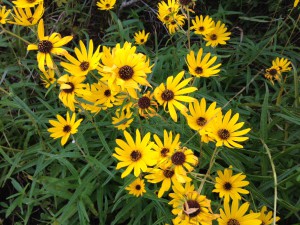
Narrowleaf Sunflower. Photo credit: Mary Derrick, UF/IFAS Extension.
This perennial starts blooming in late summer and dazzles admirers throughout autumn. The 2 to 3 inch flowers with bright yellow petals and brown centers are attractive to butterflies and other pollinators. What a great addition to your butterfly garden!
Plants generally grow to about 2 foot tall but they can grow a bit leggy to 6 foot. If desired, keep them more compact through pruning in late spring. Clumps can be divided every few years to spread them out or to share with friends and neighbors.
Like all sunflowers, it loves full sun but can tolerate some light shade. Narrowleaf sunflower is salt and flood tolerant and will do well in most soil types, however it does best in consistently moist conditions.
Narrowleaf sunflower plants may be difficult to find in the nursery trade but they can be readily started from seed.
For more information and seed sources:
Florida Wildflower Foundation
Atlas of Florida Vascular Plants: Helianthus species
Common Native Wildflowers of North Florida

by Taylor Vandiver | Aug 4, 2014
Attracting Butterflies into Your Landscape
Have you been itching to add some life and color into your landscape? Why not plant a butterfly garden?! Butterfly gardens are a great way to add movement and life to an otherwise stagnant landscape. Most butterfly gardens are not only an attractant for our Florida butterflies, but are also a magnet for hummingbirds and beneficial insects. To start your garden all you need are a few key plants.

Gulf Fritillary. Photo Courtesy Scott Jackson.
Incorporate at least one host plant and one nectar plant into your garden. The host plant provides a suitable habitat for the female butterfly to lay her eggs. These eggs will hatch and the baby caterpillars will eat the leaves of the host plant. Host plants are often not as showy as nectar plants, nor are they even necessary to attract adult butterflies. However, while nectar plants invite butterflies into your garden to feed, host plants offer them a reason to stay and reproduce. And you can watch this entire cycle unfold in your own garden!
Most of your butterfly attractant plants will do best in full sun to partial shade. Try not to apply pesticides in areas where you want to maintain healthy caterpillar/butterfly populations. Providing water for butterflies is very important and easily done. One option is to fill a clay tray with sand and then place a rock in the center, where the butterfly can perch. Keep the sand wet, but avoid standing water. Feel free to contact your local extension office for more information on our winged friends!
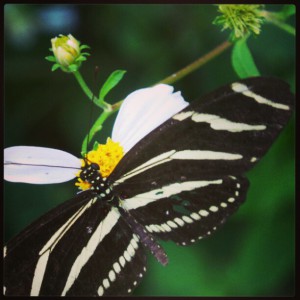
Zebra Longwing, our state butterfly! Photo courtesy Scott Jackson.
Here are a few examples of butterflies and their preferred host plants:
o Host Plants – Fennel, Parsley, Bishopsweed
o Host Plants – Pawpaw
o Host Plants – Wild Lime, Hercules-club, Citrus spp.
o Host Plants – Ash, Black Cherry, Tulip tree, Sweetbay Magnolia
o Host Plants – Partridge Pea, Cassia
o Host Plants – Passion Vines
- Zebra Longwing (State Butterfly of Florida)
o Host Plants – Passion Vines
o Host Plants – Milkweed, Butterfly Weed
Here are nectar plants that will have the butterflies swarming to your garden:
- Firebush
- Milkweed
- Blanket Flower
- Sage (Salvia spp.)
- Butterfly Bush
- Blazing Star
- Yarrow
- Pentas
- Stoke’s Aster
by Beth Bolles | Nov 11, 2013
Fall color in the Florida landscape may be a little different than more northern areas but it is just as dramatic with the right plant selections. One of the favorite perennials that is in peak bloom right now is the Cassia or butterfly plant, Cassia bicapsularis. Grown for its showy bright yellow flowers, this soft-wooded perennial can be a garden accent when grown as a small tree. Plants normally grows as a multi-stemmed plant with a vase shape or rounded canopy. Size ranges from 5-10 feet in height and the best flowering is when plants receive full sun.
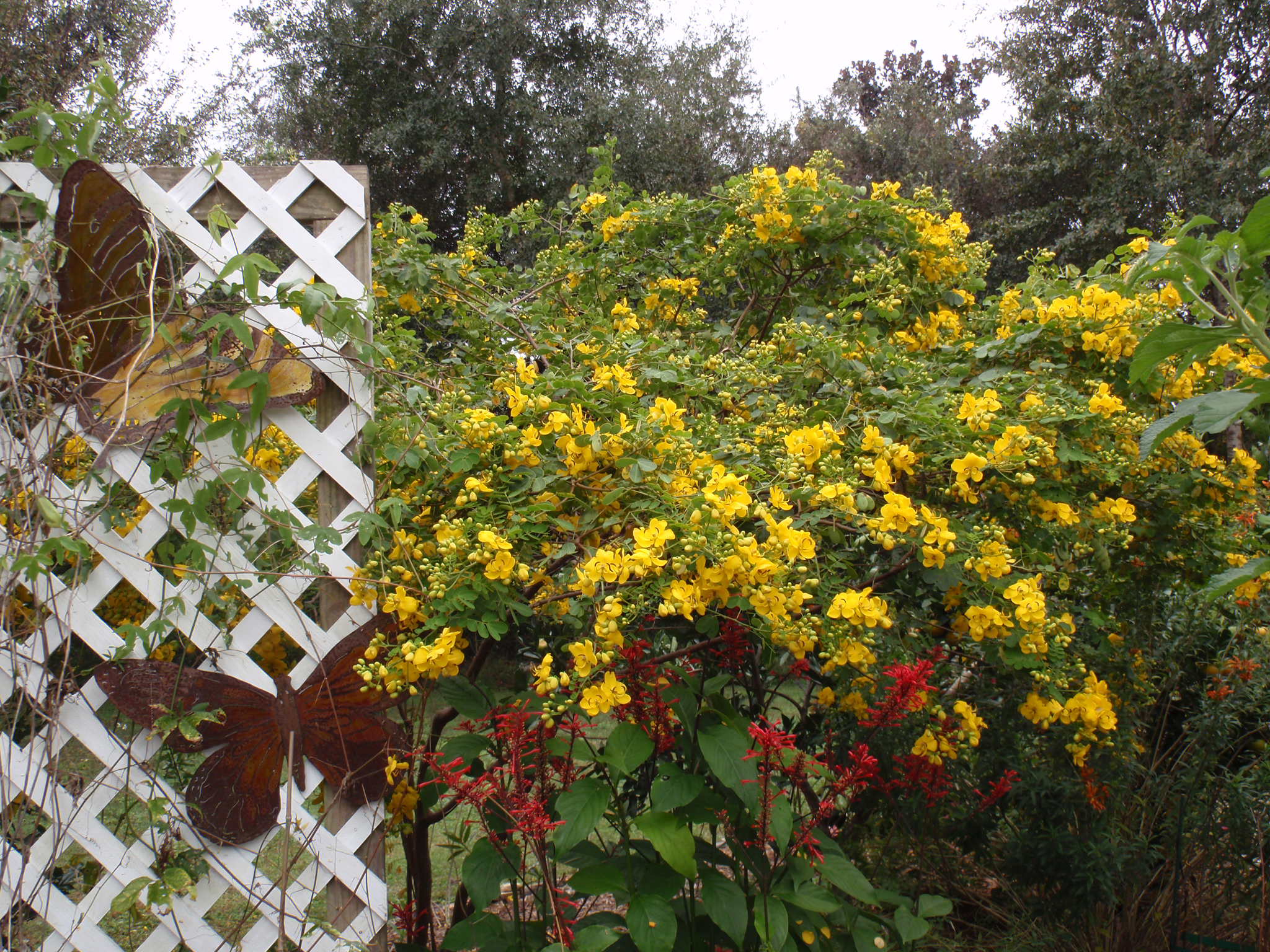
An added benefit of this species of cassia is that it can serve as a host for sulfur butterflies. Blooms will often last until first frost and plants may be injured by freezing temperatures. Homeowners will cut back cold damaged stems and wait for regrowth in the spring. During the growing season, larger plants may need support and summer storms can break some branches. Despite these issues, the fall flower show makes this a highlight in a garden. Learn more about this cassia from the University of Florida IFAS Extension.
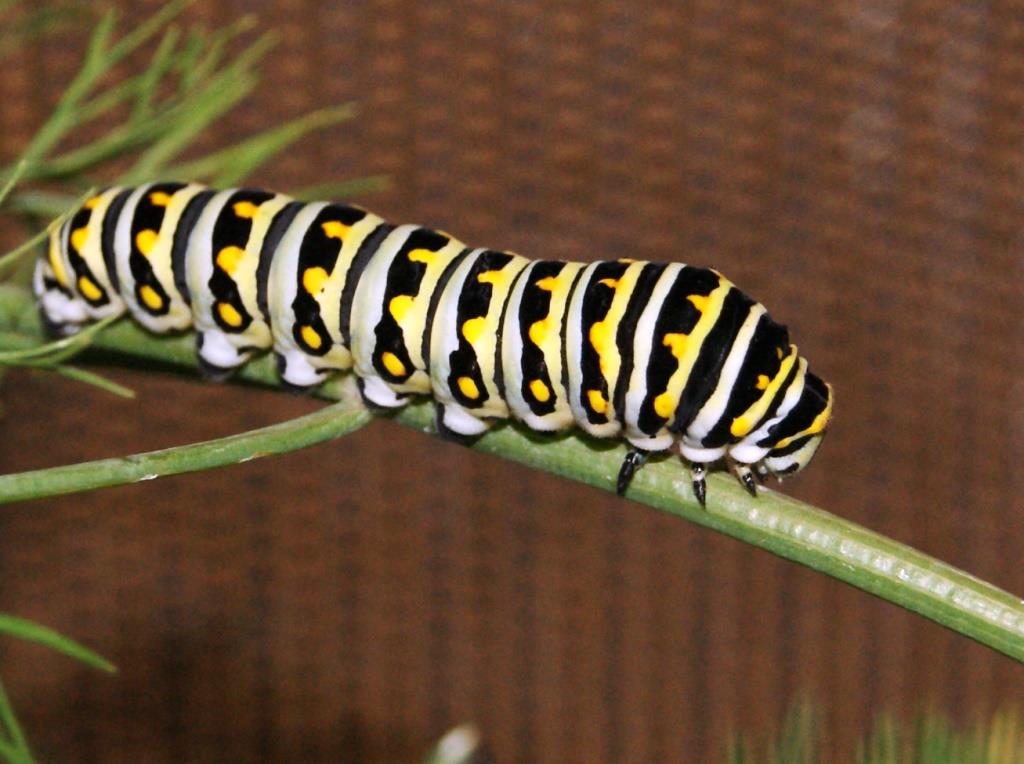
by Matthew Orwat | Oct 21, 2013

Second instar, Black Swallowtail larva. Image Credit Matthew orwat
Busily devouring dill and fennel, the lime green, black striped caterpillars in the UF IFAS Extension Washington County Office have quickly become a popular attraction. It is fortunate that the South’s climate is warm enough to allow for three generations of this species every year.
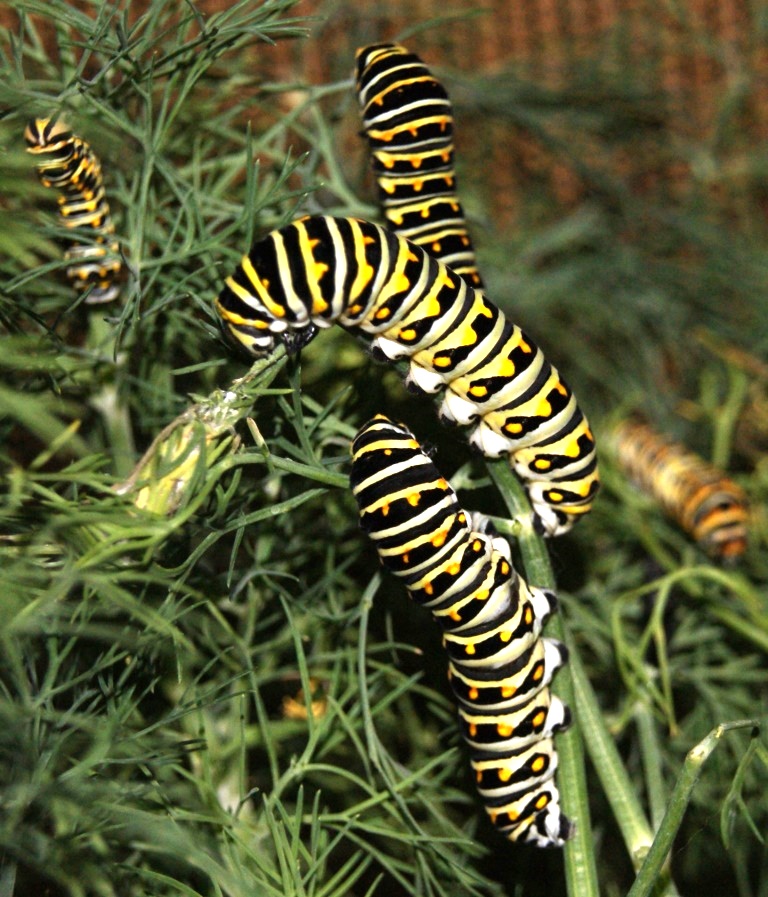
Larvae Busily Devouring Dill. Image Credit Matthew Orwat
Soon, the caterpillars of the Black Swallowtail (Papilio polyxenes asterius ) butterfly species will continue their pupae stage by forming a chrysalis and emerging as one of Florida’s most recognized swallowtail butterflies.
The chrysalis is formed by two glands located inside the caterpillar that secrete silk. The silk threads stick together and harden when exposed to fresh air. The hard, protective coating is usually camouflaged from predators and blends in with the environment. Inside the chrysalis, the process of metamorphosis continues as the adult structure forms while the juvenile structure breaks down. The insects are very inactive during this time as they grow and change. This stage can last from two weeks to an entire season in temperate climates and tropical dry seasons. When hormones indicate it’s ready, the butterfly emerges by splitting the chrysalis open either biting its way out or using spit to soften the ends.

Green Chrysalis. Image Credit Don Hall UF IFAS
The Black swallowtail has quite a heavy appetite for such a small creature. They eat a variety of plants in the carrot family (Apiaceae) such as dill, fennel, parsley, celery, and carrot leaf. In addition to these cultivated species, they will feast on mock bishopweed, roughfruit scaleseed, spotted water hemlock, water cowbane, and wedgeleaf eryngo. They have also been known to enjoy Common Rue (Ruta graveolens L.).
They exhibit several interesting behaviors throughout their life cycle. For example, when they feel threatened the Black Swallowtail larvae will exhibit yellow antennae-like structures called osmeterium. These flare out and emit a foul odor, like rotten cheese, if one’s finger gets too close.
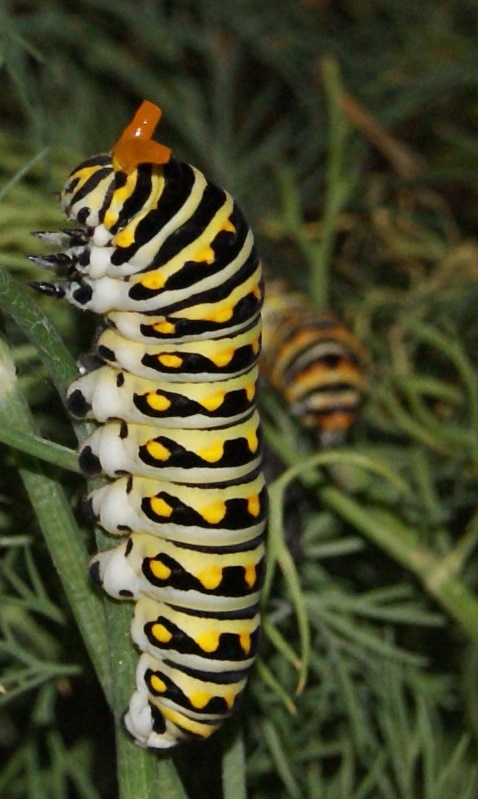
Osmeterium on display. Image Credit Matthew Orwat
Even though they are voracious plant eaters and honorable defenders of their territory, butterflies play a vital role in agriculture by pollinating crops and flowers. They’re an indicator of a healthy ecosystem; an abundance and diversity of butterfly species illustrate the overall health of an area. With their acute sensitivity to contaminants and toxins, butterfly populations will not be found in polluted areas. Recognized for their beauty, butterfly watching has also become a popular hobby and pastime.
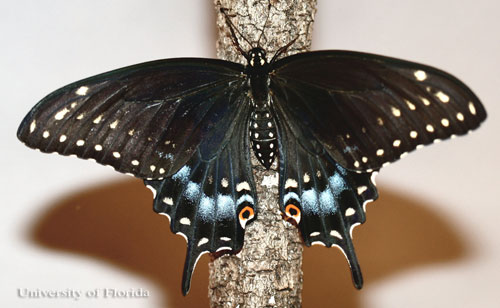
Photo courtesy of Donald Hall, University of Florida.
It’s never too early to think about planning a butterfly garden. For more information on creating a backyard butterfly habitat, download this 4-H fact sheet for kids and parents. For more information on this specific butterfly, visit the UF IFAS EDIS website for a publication on the Eastern Black Swallwtail.
Additional Content by:
Julie Pigott Dillard, Director, UF IFAS Extension Washington County
by Mary Salinas | Mar 27, 2013
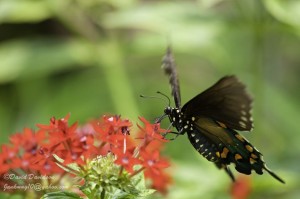
Photo courtesy of David Davidson
Butterflies are not only beautiful to look at in the landscape; they serve as important pollinators of fruiting plants. Attracting them to the garden and incorporating some features to get them to stay and reproduce involves advanced planning. Some steps to achieve butterfly garden optimization are outlined below.
- Choose a location that provides some protection from wind. Trees and shrubs that provide wind protection also serve as a safe harbor from rain and predators.
- The garden should offer both sunny and partially sunny environments.
- Ensure that any new plantings have access to a convenient irrigation source. A plentiful water source allows butterflies to be successfully established and maintained in good health.
Now plants need to be chosen. Adults feed on the nectar of many flowering trees, shrubs, perennials, and annuals. Fortunately, there are usually many choices that will meet diverse site requirements and varied taste preferences. In order to retain garden butterflies, certain plants need to be available to serve as host plants for their young. Here are a few hits to assist with this selection process.
- Determine which species of butterfly is common in a given geographical area. Most species have very few plants on which the caterpillars can feed, so host plants need to be chosen wisely.
- Determine whether any of the existing plants are host plants and if they are appropriate for a butterfly garden. For example, cassia is a host plant for the Cloudless Sulphur and citrus is a host plant for the Giant Swallowtail.
- In choosing nectar plants, select those that are native or Florida-Friendly as they are lower maintenance, and less troublesome in the long run.
- Choose plants that have flowers in a variety of color, size, and shape. Different butterflies like to feed at different elevations, so choose trees, shrubs, perennials, and annuals of varying heights.
- In order to have nectar available throughout the time when the butterflies occur, include plants that bloom at different times of the year. And include some plants that bloom all the time, like pentas or moss verbena.
Larger plants should be placed in the background with smaller plants layered in the foreground. When planting smaller annuals and perennials, place them in masses to better attract the butterflies. Consider placing host plants in an area that is in close proximity to the nectar plants, but in an area of your garden that is not a focal point. Host plants can get quite ragged looking from hungry caterpillars!
Good maintenance practices will enhance garden health. Regular fertilization, and as needed irrigation, will help keep garden plants in bloom and healthy – healthy plants are less susceptible to disease and pests. Avoid pesticides as they may harm butterflies and other beneficial insects. Never use a Bt or systemic pesticide since these target butterfly larvae. Lower risk oils or soaps are useful in treating localized insect infestations however. Lastly, be aware of beneficial insects that will help achieve satisfactory pest control.
Once the plants are placed there are several things to do to complete the butterfly garden.
- Add a spot where water can puddle on the ground for the adult butterflies to drink. They require minerals from the soil that get dissolved in the water.
- Also add a rock or log in a sunny spot where butterflies can rest and sun themselves.
- Consider placing a comfortable place for you to sit and enjoy the beauty of your garden and its inhabitants!
For more infortmation on butterfly gardening and for a plant list, please check out Butterfly Gardening in Florida
Enjoy the Butterflies !













